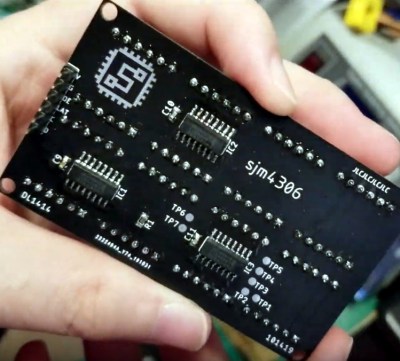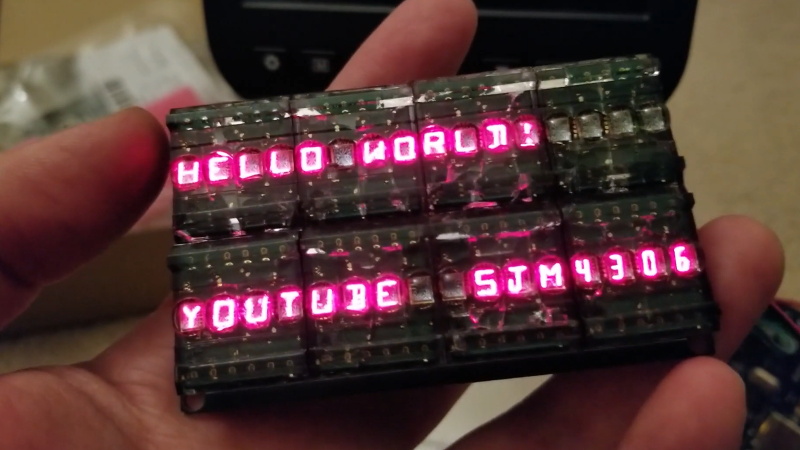We’ve recently noticed an uptick of interest in so-called “bubble displays”: vintage alphanumeric LEDs which are probably best remembered as being used in watches and calculators before the LCD took over. Today they’re available as surplus or even salvage for literally pennies, but unfortunately they only provide four or five characters to work with. Or rather they did, until [sjm4306] built a board that chains them into a 16×2 array.
 For the princely sum of 71 cents each, [sjm4306] picked up ten HPDL-1414 displays, each capable of showing four characters. He then designed a PCB that would accept eight of the displays at once, and even thought ahead to use headers so they could be pulled out and swapped as needed. Of course mounting them is only half the battle, you still need to drive the things.
For the princely sum of 71 cents each, [sjm4306] picked up ten HPDL-1414 displays, each capable of showing four characters. He then designed a PCB that would accept eight of the displays at once, and even thought ahead to use headers so they could be pulled out and swapped as needed. Of course mounting them is only half the battle, you still need to drive the things.
Each display has its own dedicated driver chip on board, but trying to address each one individually would take far too many pins. So [sjm4306] opted to use a trio of 74HC595 shift registers, allowing him to toggle the three dozen pins necessary over SPI from a microcontroller. He’s even written up a little library and some example code that you can grab on the project’s Hackaday.io page.
Unfortunately, after all his hard work, tragedy struck. As these displays were a couple decades old given their date code, [sjm4306] thought he would clean them up with a bit of alcohol before their big video debut. But whatever plastic the clear panels are made of didn’t take kindly to the IPA, and they all shattered. They still work, but it’s definitely a quirk to keep in mind if you pick up some of these vintage displays to play with yourself.
In the past we’ve seen a much smaller PCB that allowed similar displays to more easily be interfaced with modern microcontrollers; perfect if you just want to bang out a few retro LED characters with a minimum of fuss.
















re: Plastic shattering with IPA
The same thing happened to me when I was restoring some buttons on an old HP signal generator. After a few scrubs with a IPA soaked rag some of the buttons just crumbled. What kind of plastic does that?!?
According to google, acrylic doesn’t get along with IPA and can shatter.
My uneducated random guess: plasticizers are volatile and eventually plastic becomes really brittle as it outgasses with age, and perhaps if enough of it was missing the IPA could penetrate into the plastic in the spaces where the plasticizers used to be and cause that kind of crazy reaction. IDK, just speculation.
I learned to avoid all solvents with any plastic without testing when I ruined the panel on my Nakamichi 4-track unit back in th 80’s. I have made a few mistakes since then, every time cursing myself.
When i bother to think, I tend towards a lint-free wipe moistened with DI water for most things, and maybe a tiny bit of mild dish detergent mixed in, unless the application is a true no-H2O case. Don’t rub, just gently press, let any contamination dissolve, and a dry lint-free to wick it off. Microscope lenses, old electronics, camera parts, pretty much any glass or plastic surface. It takes a little more time than some other methods, but a lot less time and money than replacing parts.
FYI: https://www.tdiinternational.com/technical-source-product-info/chemical-compatibility-charts/acrylic/
>Isopropyl Alcohol, to 50% Limited Resistance (Short Time Compatibility)
also
>Ethyl Alcohol, Absolute Not Resistant (Not Compatible)
>Ethyl Alcohol, to 30% Limited Resistance (Short Time Compatibility)
Wow! I had no idea! I always thought alcohol was safe on everything except exotic coatings and waterbase paint! Thanks!
Crazing is the term. It is a well-known failure mode for plastics exposed to alcohol..
Crazy, man!
It sure drove me crazing … erm I mean crazy!
Did you use Krazy Glue to make repairs?
Are you crazy, using krazy glue to fill the cracks from crazing?!?! Krazy glue can cause clouding of certain plastics! (Not quite a tongue twister but getting there …)
Nice use of these displays. One example of equipment it was common in is from 20+ year old AMPS/TDMA Nortel TRU2 base station radio. An 8 character display on the front panel. Since these are scrap, they are available for the time it takes to take the TRU2 apart. Shame of it is that is the only thing I found reusable on this very nice equipment of its time.
Nokia GSM BTS TRXA and TRXB transceiver units from 900MHz and 1800MHz sites also have these!
All of mine come from scrapping these for parts.
While bubble displays were everywhere in the 1970’s — it was either stupidly expensive or just plain impossible to make LED displays that didn’t require the magnifying bubbles, and LCD’s were just becoming practical — these being 15-segment alphanumeric displays are pretty unusual even for the era. Most devices that needed alphanumeric output were fixed in place and expensive enough to justify vacuum flourescent displays. I’ve never seen an actual 15-segment bubble in person, and now I’m tempted to head off to eBay.
8-segment bubble displays were common in calculators.
HP used them on the HP-35 and HP-45, the two calcs I lusted over as a college student. Was finally able to affor an HP-25 in grad school. I still have it, and yes, it has bubble displays.
I have some encapsulated in red without the bubbles. Each segment is made up of a series of tiny LEDs a bit more spaced out giving them a dot matrix look. I think they are made by National. I also got some bubble ones encapsulated in clear epoxy with the same DIP footprint.
“But whatever plastic the clear panels are made of didn’t take kindly to the IPA, and they all shattered. ”
And now part II, the casting of plastic lenses aka “bubbles”.
HPDL-1414 prices on eBay skyrocketing in 5…. 4… 3… 2… 1…
I built something similar many years ago but only made a 1 line 16 char and gave it a serial input. I still have a box of the 1414 displays I was planning on making a 16×4 screen with.
Nice to see them, I love the look of these.
I would love to make a 40×4 version of this next, just kinda stinks that vertical spacing on the 1414 is so wide.
Maybe you could use mirrors to reflect them closer together.
It’s been a long time (2013!), but here my small hpdl-1414 clock is enjoying another moment to show itself.
https://www.youtube.com/watch?v=X6pWpAnn9J8
https://www.youtube.com/watch?v=H-n53o-2VUA
//Marcus
Fantastic, I love how tiny it is!
It’s been a long time (2001!), but here’s my small DL-1414T text scroller.
Interestingly though, by now the plastic has cracked and two of the data lines are internally severed!
https://cdn.hackaday.io/images/resize/600×600/1651691408467442955.jpg
Each HPDL14140 (from datatsheet) with all its LEDs lit consumes 100ma at 5V so with 8 displays you’ll need nearly an amp (peak) to power the array. Probably not a replacement for an old 16×2 LCD that wants 2ma. But … I’ve got about 20 of these in my junk box and a bunch of CD4094s (instead of the 75HC595s) so I’m definitely going to try to build a thru-hole version.
From my measurements with just about all digits lit by random characters (but not all segments) current sits at around 400-500mA. Definitely not a replacement for an lcd when efficiency is the goal but it sure looks beautiful (and gets nice and warm for those cold days).